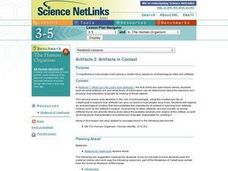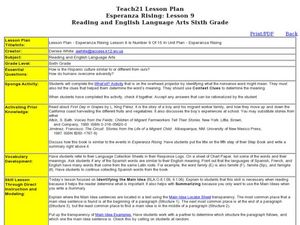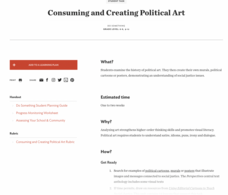Curated OER
Using Context Clues
Middle schoolers receive a handout that lists the five types of context clues. The class divides up into groups of three or four, and each group chooses five unfamiliar words. They write a multiple-choice question for each of their five...
Curated OER
Self-Monitoring Strategies and Vocabulary Games
Middle and high schoolers identify how to discover a word's meaning by exploring context clues and any pictures, diagrams, photographs, and charts that might be included. They continue this process with other examples and locate one on...
Curated OER
Introducing New Vocabulary Words
Using context clues, synonyms, antonyms, dictionaries, and original sentences, middle schoolers work through a new list of vocabulary words. A SMART board file guides them through the process of learning and reinforcing the words. After...
Curated OER
Mystery Words
In this language arts activity, 8th graders verify the meaning of a word in its context, even when its meaning is not directly stated. After a class discussion on how to use context clues, students pairs are given a worksheet of "mystery...
Curated OER
Picture This
A unique writing lesson, this plan begins with learners talking about multiculturalism in small groups. Each learner will choose a picture from a newspaper, describe it to their small group, and think about how it relates to...
Curated OER
Comic Strip Context Clues
Second graders create dialogue for a comic strip using context clues to match the text to the pictures. They use comic blanks imbedded in this lesson. They write dialogue for each frame. Remind them to use the picture clues when writing...
Curated OER
Sequence, Predict, Infer: Pink and Say
Practice sequencing with your 2nd graders via Patricia Polacco's Civil War book Pink and Say. Begin with a blindfold and a bag of mystery items. Connect their use of clues to identify what they can't see with the skill of making...
Curated OER
Old Lady That Swallowed a Fly
Youngsters listen to the story, "There Was an Old Lady Who Swallowed a Fly." After discussing the story, going over new vocabulary, and repeating the rhymes in the story, they study the parts of a fly. They finish by creating a fly on...
Curated OER
Beowulf: Songs of Ancient Heroes
Introduce your class to epic heroes with these activities for Beowulf. After watching a video clip, taking notes on heroes, and tracking characteristics of heroism throughout Beowulf, class members retell an episode of Beowulf using a...
Curated OER
Minibeasts and Reading Strategies
Fourth graders explore reading strategies through roleplaying. In this reading lesson, 4th graders read Wings, Stings, and Wiggly Things by Martin Jenkins. Student groups pretend to be a law firm and identify words as their evidence to...
Curated OER
Picture Clues and Repeated Text
Kids read The Grouchy Ladybug and predict what the outcome will be based on picture clues and repeated text. Next, they draw their predictions. A great way to use both prediction and context clue skills in your kindergarten class.
Curated OER
The Diary of Anne Frank
Eighth graders read the Diary of Anne Frank. In this novel reading instructional activity, 8th graders read and analyze the story. Students do online activities and create a newspaper giving a summary of three major events in the story....
Curated OER
Word Wonders
Pupils read passages and use phonics and context clues to self correct themselves while reading. In this reading lesson, students complete a worksheet which is embedded in the plan which has them choose the correct word to complete...
Curated OER
Defining Moments
Seventh graders use context clues to define words. In this language arts lesson, 7th graders engage in a class discussion regarding how we determine the meaning of words that we aren't familiar with. Then, students complete a very good...
Curated OER
A House Divided: Photography in the Civil War
Pupils study Civil War photography and write captions for each picture based on context. In this Civil War photography lesson, students match photographs with their original captions. Pupils read included short biographies of the...
Curated OER
Where Were Your Ancestors in 1871?
Here is a nicely designed lesson on ancestry and family history. In it, learners read an article entitled, "Where Were Your Ancestors in 1871?" Then, they make up a series of questions to profile their family and their community 100...
Curated OER
Artifacts 2: Artifacts in Context
Students explore world history by completing artifact worksheets. In this archaeology instructional activity, students identify the importance of finding clues when researching historical information by utilizing artifacts. Students...
Curated OER
Esperanza Rising: Lesson 9
Sixth graders explore culture by reading a book with classmates. In this Hispanic history lesson, 6th graders read the story First Day in Grapes, and discuss the tough lives of migrant workers. Students answer study questions after the...
Curated OER
Random Acts of Kindness For Kids
Develop a world-wide, email chain on which class members can showcase their acts of kindness. After defining the meaning of random acts of kindness through discussion and through a reading of Random Acts of Kindness,...
Curated OER
Esperanza Rising: Lesson 3
Sixth graders read parts of the book Esperanza Rising and define vocabulary words connected to it. In this Esperanza Rising lesson plan, 6th graders illustrate words and discuss the sections of the books they read.
Curated OER
Life's Lessons: Survival of the Fittest
Students analyze Jack London's use of anthropomorphism to identify the importance of adaptability in life. In this literature lesson, students use the novel The Call of the Wild to identify key elements in survival. Students...
Curated OER
Rollin’ on the River: Identifying Jargon
Learners identify jargon in poetry, prose and fiction. In this literature lesson, students will read selections from Mark Twain and identify figurative langauge, focusing on jargon.
Curated OER
Character in a Box
Partners choose, research, and analyze fictional or historical characters and design character life boxes to represent them. They also compose a rhyme royal, which they understand inductively by deconstructing examples. Based largely on...
Teaching Tolerance
Consuming and Creating Political Art
A picture is worth a thousand words, but political art may be worth even more! After examining examples of political cartoons, murals, and other forms of public art, class members create their own pieces to reflect their ideals and...























